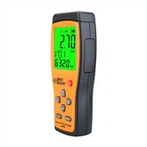Precautions for Using Coating Thickness Gauges in Applications
The coating thickness gauge has measurement errors due to the different distribution forms of electromagnetic fields on different surface structures. To avoid errors caused by operation, please follow the following principles when using:
1. When repeating measurements at the same point, keep the probe at least 10cm away and wait for a few seconds before retesting to avoid affecting the next measurement result due to the magnetization of the tested material by the probe;
2. When in use, zero the plane to measure the plane, zero the convex surface to measure the convex surface, and zero the concave surface to measure the concave surface to avoid measurement errors caused by different structures;
3. Try to use the tested material as the zeroing matrix as much as possible to avoid measurement errors caused by different magnetic conductivities of different materials;
4. Try to zero the same part of the tested material before measuring the same part. For example, the edges and middle of the workpiece should be zeroed separately;
5. The surface for adjusting the allowance should be as smooth as possible; The surface roughness of the tested material has a significant impact on the measured values. If the surface is not smooth, the average value should be taken depending on the situation;
6. When measuring, the probe should be kept perpendicular to the surface of the measured material, otherwise significant errors may occur.
Principle of Magnetic Attraction Measurement and Thickness Gauge
The suction force between iron (probe) and magnetic steel is proportional to the distance between the two, which is the thickness of the coating. Using this principle to make a thickness gauge, as long as the difference in magnetic permeability between the coating and the substrate is large enough, measurement can be carried out. Given that most industrial products are formed by stamping structural steel and hot-rolled cold-rolled steel plates, magnetic thickness gauges are widely used. The basic structure of the thickness gauge consists of magnetic steel, relay spring, ruler, and self stopping mechanism. After the magnetic steel is attracted to the object being measured, the measuring spring gradually elongates behind it, and the tension gradually increases. When the tensile force is just greater than the suction force, the thickness of the coating can be obtained by recording the magnitude of the tensile force at the moment when the magnetic steel separates. The new product can automatically complete this recording process. Different models have different ranges and applicable scenarios. The characteristics of this instrument are easy operation, sturdy and durable, no need for power supply, no need for calibration before measurement, and low price, making it very suitable for on-site quality control in workshops.






